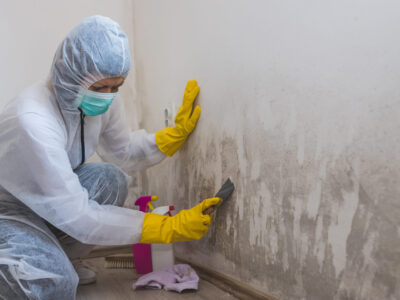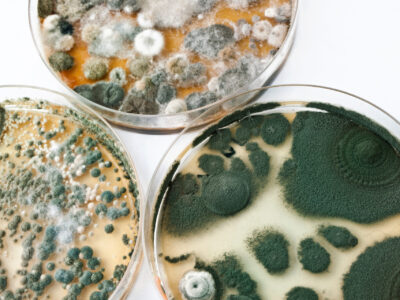A part of the highly diverse and complex fungus family, mold is a living, microbial organism that grows from certain fungi and reproduces as a part of its life cycle. With over 100,000 types of molds and mold-producing fungi all over the world, the most common allergy-inducing types include:
- Alternaria – Molds from the Alternaria genus commonly grow in outdoor environments and on damp indoor materials.
- Aspergillus – Most molds from the Aspergillus genus will grow in the right environments both indoors and outdoors.
- Cladosporium – Molds from the Cladosporium genus tend to grow indoors and are often mistaken for the dreaded toxic black mold because of their similar appearances.
- Penicillium – Molds from the Penicillium genus commonly grow on decaying foods. As its name suggests, some of these mold species are used to create the antibiotic penicillin.
What Causes Mold Allergies?

All mold types and their parent fungi grow in moist or damp environments, both inside and outside, and mold spreads via its “seeds,” better known as spores. Mold spores are microscopic and light enough to float up into the air whenever the growth site is disturbed, making them easy to inhale. Whether traipsing through the forest on a hike or standing in a poorly ventilated room with high levels of moisture, it is possible to breathe in mold spores and experience an allergic reaction.
Why Might I Have a Mold Allergy?
Not all people are allergic to mold spores, but those with a mold allergy have an immune system that will treat the spores like a threat once encountered. If triggered, the immune system will overreact in an effort to flush the spores from the body, causing the patient to experience frustrating allergy symptoms.
Common Mold Allergy Symptoms
- Congestion
- Excessive coughing
- Excessive sneezing
- Eye irritation
- Skin rash
- Throat irritation
Asthma patients can experience additional symptoms if they encounter mold spores, including troubled breathing. Signs of troubled breathing include:
- Chest tightness
- Shortness of breath
- Wheezing
Is a Mold Allergy Dangerous?
As mentioned, not all people have immune systems that react to mold spores, meaning they do not suffer from allergic reactions the same way mold allergy patients do. Also, mold allergies are no more dangerous than allergies to other triggers like pollen, pet dander, or dust mites. Patients with a severe allergy to mold do risk experiencing anaphylaxis.
What About Toxic Mold?

There are toxigenic molds that can be harmful to anyone exposed, whether the person has a mold allergy or not. Not all molds are toxigenic, but all toxigenic molds can be dangerous to encounter since they produce tiny toxic particles called mycotoxins in addition to their spores.
One of the most infamous toxigenic molds is Stachybotrys chartarum, more commonly known as toxic black mold. Along with possible allergic reactions to spores, a person exposed to any mycotoxins can also experience or develop:
- Acute poisoning (like headaches or nausea)
- Respiratory disease following prolonged exposure
- Chronic illness, including chronic inflammatory response syndrome (CIRS) following prolonged exposure
What Are Three Signs of a Mold Allergy?
If you suspect you have an allergy to mold, pay attention to indicators like:
1. Developing Allergy Symptoms After Entering an Older Building
Older buildings, such as historic homes or office buildings, lend themselves to developing mold problems over time due to age-related wear and tear of their building materials and their increased likelihood of developing moisture issues. Older buildings are often a breeding ground for mold growth, which can trigger allergic reactions among those inside.
If you find yourself experiencing allergy symptoms inside an older building that clear up after you exit, you may have a mold allergy.
2. Developing Allergy Symptoms in the Attic, Basement, or Crawl Space
Your house does not have to be old to have a mold issue, especially in areas that tend to have high moisture levels and poor ventilation. Attics, basements, and crawl spaces are the most common areas of the house where moisture levels remain high and where mold often develops.
If you develop allergy symptoms whenever you are in your attic, basement, or crawl space that fade after you leave the area, you could have both a mold allergy and a mold issue.
3. Developing Allergy Symptoms When Outdoors, Especially in the Fall or Winter
Pollen is the king of allergy triggers during the spring and summer months and can make it difficult for allergy patients to enjoy the outdoors during this time. However, if you experience similar allergy symptoms in outdoor spaces during fall and winter, you could be allergic to the mold spores in the air outside.
The best way to know if you truly have a mold allergy is by scheduling a comprehensive allergy test at Langford Allergy.
Dr. Langford and our team offer thorough allergy testing and can help you determine if mold spores are a trigger for you or not. No matter you symptoms or triggers, we will create an effective treatment and management plan to ensure you are prepared for any allergens life throws your way. Schedule an appointment or call our office to learn more: 478-787-4728
Related articles:
Start 2023 on the Right Foot with a Comprehensive Allergy Test
